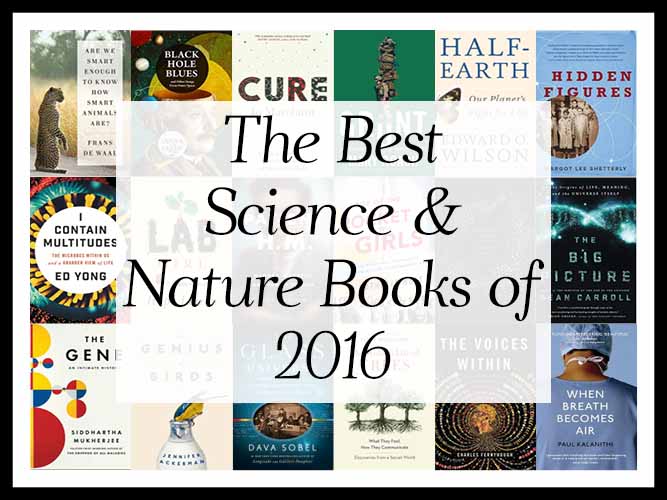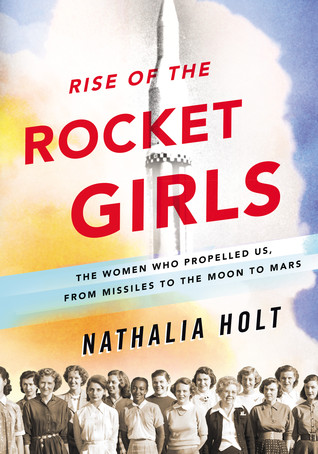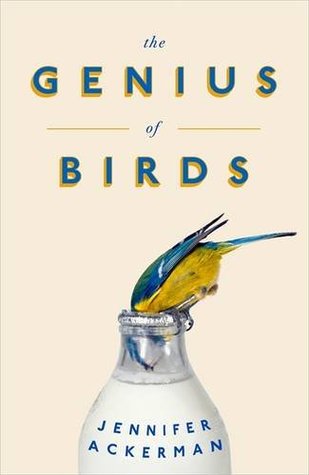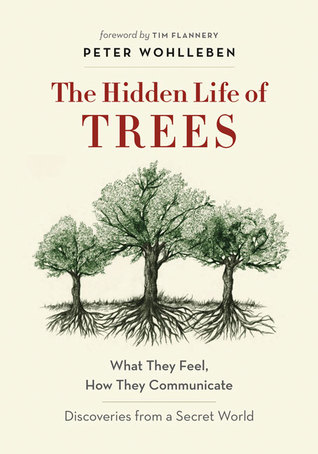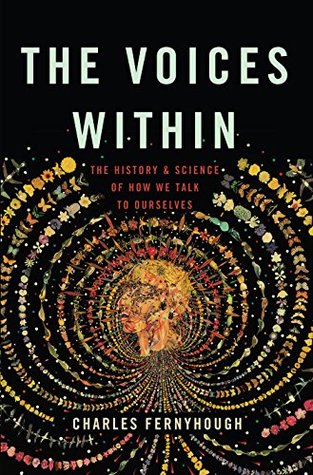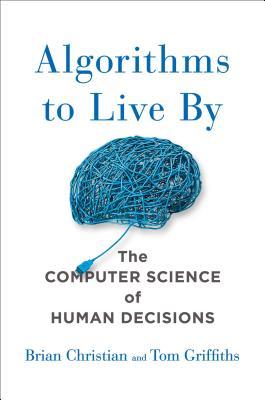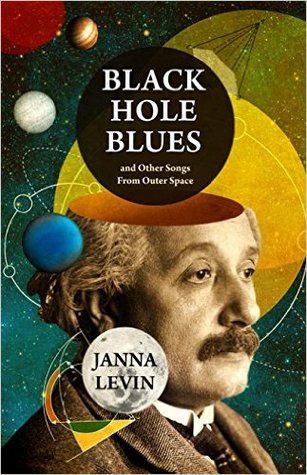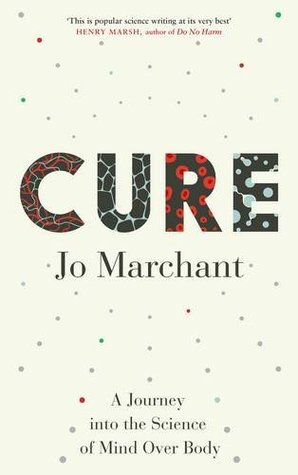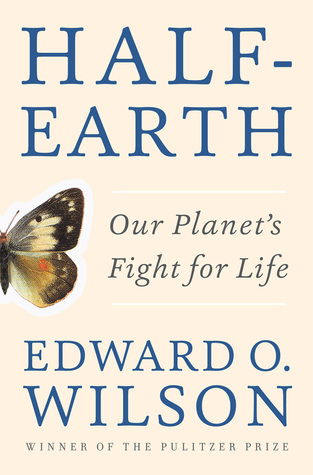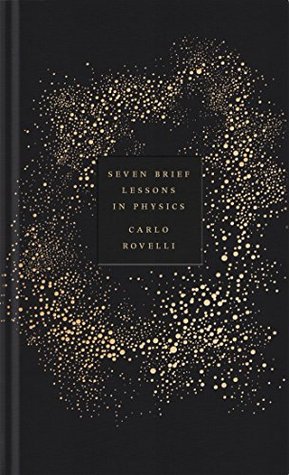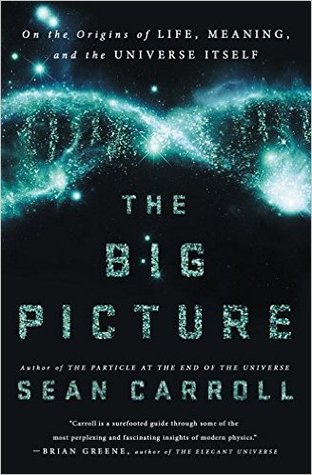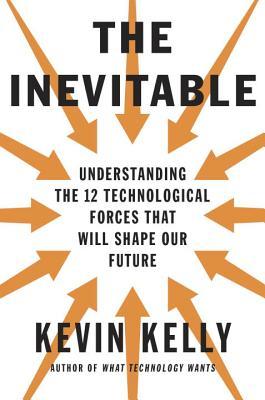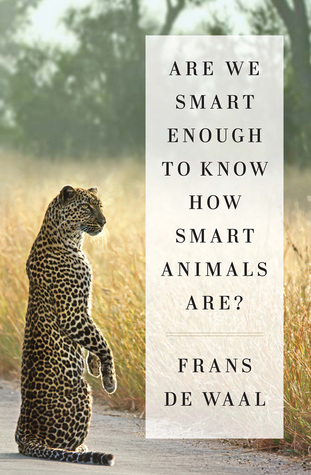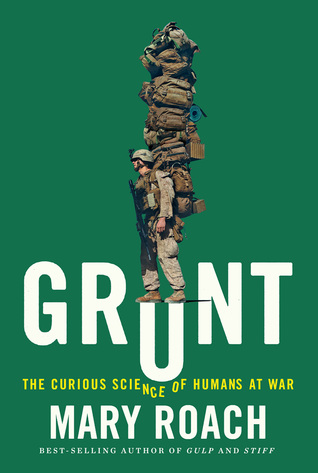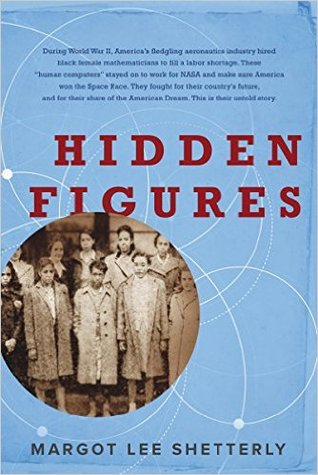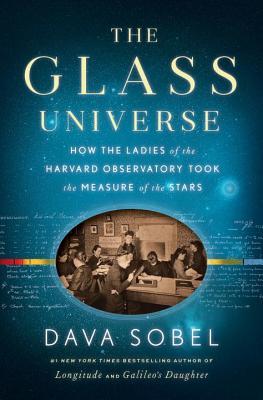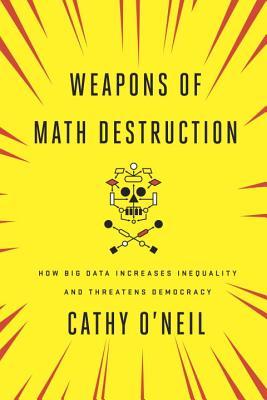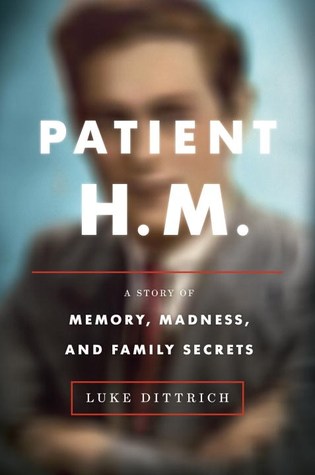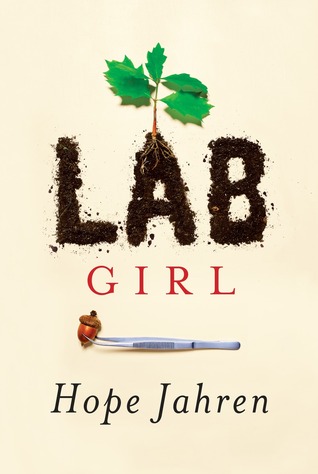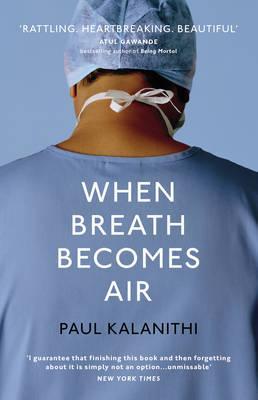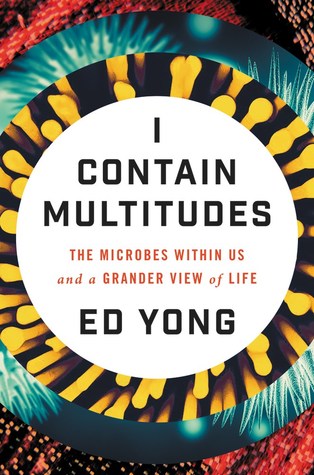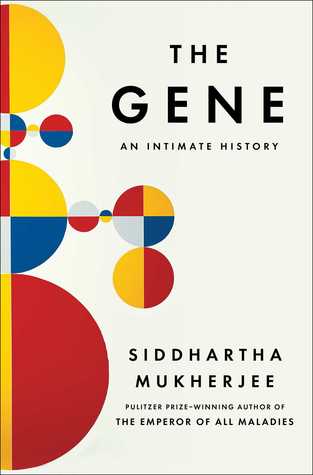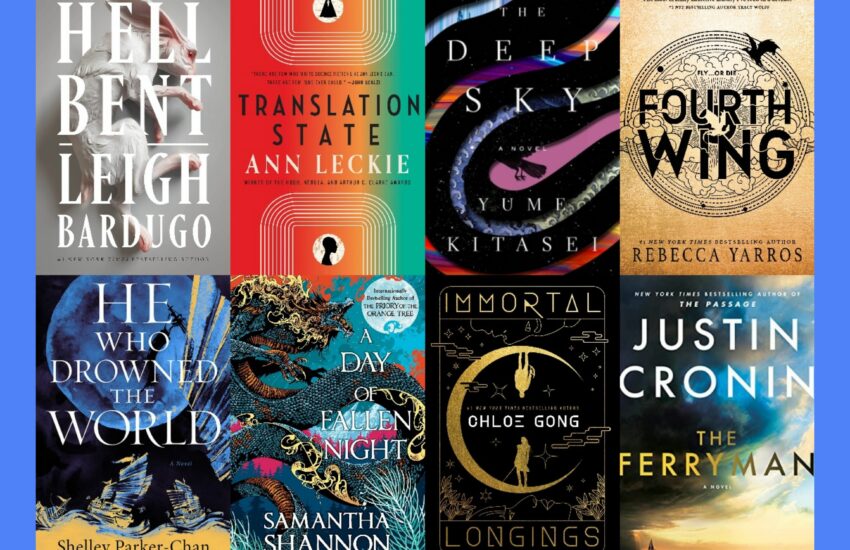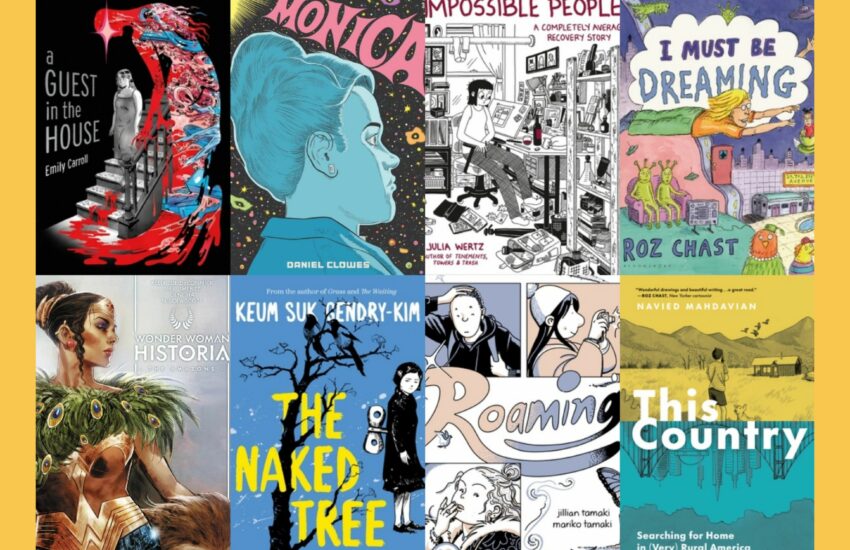The Best Science & Nature Books of 2016 (A Year-End List Aggregation)
“What are the best Science and Nature Books of 2016?” We aggregated 46 year-end lists and ranked the 363 unique titles by how many times they appeared in an attempt to answer that very question!
There are thousands of year-end lists released every year and, like we do in our weekly Best Book articles, we wanted to see which books appear on them the most. We used 46 lists and found 363 unique titles. The top 21 books, all appearing on 3 or more lists, are below with images, summaries, and links for learning more or purchasing. The remaining books, along with the articles we used, can be found at the bottom of the page.
Be sure to check out our other Best Book of the year lists:
- The Best Fiction Books of 2016
- The Best Nonfiction Books of 2016
- The Best Science Fiction & Fantasy Books of 2016
- The Best Cookbooks of 2016
- The Best Art & Photography Books of 2016
- The Best Graphic Novels & Comics of 2016
- The Best Poetry Books of 2016
- The Best Biography & Memoir Books of 2016
- The Best History Books of 2016
And if you want to see how they compare to last year, take a look at the 2015 lists as well!
Happy Scrolling!
The Top Science and Nature Books of 2016
21 .) Rise of the Rocket Girls: The Women Who Propelled Us by Nathalia Holt
- Nature
- Amazon
- Technology Review
“In the 1940s and 50s, when the newly minted Jet Propulsion Laboratory needed quick-thinking mathematicians to calculate velocities and plot trajectories, they didn’t turn to male graduates. Rather, they recruited an elite group of young women who, with only pencil, paper, and mathematical prowess, transformed rocket design, helped bring about the first American satellites, and made the exploration of the solar system possible.
For the first time, Rise of the Rocket Girls tells the stories of these women–known as “”human computers””–who broke the boundaries of both gender and science. Based on extensive research and interviews with all the living members of the team, Rise of the Rocket Girls offers a unique perspective on the role of women in science: both where we’ve been, and the far reaches of space to which we’re heading. “
20 .) The Genius of Birds by Jennifer Ackerman
- Goodreads
- The Seminary Co-op
- The Vore
“In The Genius of Birds, acclaimed author Jennifer Ackerman explores the newly discovered brilliance of birds. As she travels around the world to the most cutting-edge frontiers of research—the distant laboratories of Barbados and New Caledonia, the great tit communities of the United Kingdom and the bowerbird habitats of Australia, the ravaged mid-Atlantic coast after Hurricane Sandy and the warming mountains of central Virginia and the western states—Ackerman not only tells the story of the recently uncovered genius of birds but also delves deeply into the latest findings about the bird brain itself that are shifting our view of what it means to be intelligent.
Consider, as Ackerman does, the Clark’s nutcracker, a bird that can hide as many as 30,000 seeds over dozens of square miles and remember several months later where it put them, or the mockingbirds and thrashers, species that can store 200 to 2,000 different songs in a brain a thousand times smaller than ours.”
19 .) The Hidden Life of Trees: What They Feel, How They Communicate—Discoveries from a Secret World by Peter Wohlleben and Tim Flannery
- Brain Pickings
- Dirt
- Amazon
Are trees social beings? In this international bestseller, forester and author Peter Wohlleben convincingly makes the case that, yes, the forest is a social network. He draws on groundbreaking scientific discoveries to describe how trees are like human families: tree parents live together with their children, communicate with them, support them as they grow, share nutrients with those who are sick or struggling, and even warn each other of impending dangers. Wohlleben also shares his deep love of woods and forests, explaining the amazing processes of life, death, and regeneration he has observed in his woodland.
18 .) The Voices Within: The history and science of how we talk to ourselves by Charles Fernyhough
- ABC
- The Guardian 2
- Forbes
When someone says they hear voices in their head, they are often thought to be mentally ill. But, as Charles Fernyhough argues in The Voices Within, such voices are better understood as one of the chief hallmarks of human thought. Our inner voices can be self-assured, funny, profound, hesitant, or mean; they can appear in different accents and even in sign language. We all hear them—and we needn’t fear them. Indeed, we cannot live without them: we need them, whether to make decisions or to bring a book’s characters to life as we read. Studying them can enrich our understanding of ourselves, and our understanding of the world around us; it can help us understand the experiences of visionary saints, who might otherwise be dismissed as schizophrenics; to alleviate the suffering of those who do have mental health problems; and to understand why the person next to us on the subway just burst out laughing for no apparent reason.
17 .) Algorithms to Live By: The Computer Science of Human Decisions by Brian Christian and Tom Griffiths
- Amazon
- Goodreads
- Forbes
- Technology Review
“All our lives are constrained by limited space and time, limits that give rise to a particular set of problems. What should we do, or leave undone, in a day or a lifetime? How much messiness should we accept? What balance of new activities and familiar favorites is the most fulfilling? These may seem like uniquely human quandaries, but they are not: computers, too, face the same constraints, so computer scientists have been grappling with their version of such issues for decades. And the solutions they’ve found have much to teach us.
In a dazzlingly interdisciplinary work, acclaimed author Brian Christian and cognitive scientist Tom Griffiths show how the algorithms used by computers can also untangle very human questions. They explain how to have better hunches and when to leave things to chance, how to deal with overwhelming choices and how best to connect with others. From finding a spouse to finding a parking spot, from organizing one’s inbox to understanding the workings of memory, Algorithms to Live By transforms the wisdom of computer science into strategies for human living.”
16 .) Black Hole Blues and Other Songs from Outer Space by Janna Levin
- Brain Pickings
- Amazon
- Kirkus
- Symmetry
In Black Hole Blues and Other Songs from Outer Space, Janna Levin recounts the fascinating story of the obsessions, the aspirations, and the trials of the scientists who embarked on an arduous, fifty-year endeavor to capture these elusive waves. An experimental ambition that began as an amusing thought experiment, a mad idea, became the object of fixation for the original architects—Rai Weiss, Kip Thorne, and Ron Drever. Striving to make the ambition a reality, the original three gradually accumulated an international team of hundreds. As this book was written, two massive instruments of remarkably delicate sensitivity were brought to advanced capability. As the book draws to a close, five decades after the experimental ambition began, the team races to intercept a wisp of a sound with two colossal machines, hoping to succeed in time for the centenary of Einstein’s most radical idea. Janna Levin’s absorbing account of the surprises, disappointments, achievements, and risks in this unfolding story offers a portrait of modern science that is unlike anything we’ve seen before.
15 .) Cure: A Journey into the Science of Mind Over Body by Jo Marchant
- Science of Us
- Goodreads
- The Economist
- Forbes
“Have you ever felt a surge of adrenaline after narrowly avoiding an accident? Salivated at the sight (or thought) of a sour lemon? Felt turned on just from hearing your partner’s voice? If so, then you’ve experienced how dramatically the workings of your mind can affect your body.
Yet while we accept that stress or anxiety can damage our health, the idea of “”healing thoughts”” was long ago hijacked by New Age gurus and spiritual healers. Recently, however, serious scientists from a range of fields have been uncovering evidence that our thoughts, emotions and beliefs can ease pain, heal wounds, fend off infection and heart disease and even slow the progression of AIDS and some cancers.”
14 .) Half-Earth: Our Planet’s Fight for Life by Edward O. Wilson
- Amazon
- Dirt
- Nature
- Geographical
“In order to stave off the mass extinction of species, including our own, we must move swiftly to preserve the biodiversity of our planet, says Edward O. Wilson in his most impassioned book to date. Half-Earth argues that the situation facing us is too large to be solved piecemeal and proposes a solution commensurate with the magnitude of the problem: dedicate fully half the surface of the Earth to nature.
If we are to undertake such an ambitious endeavor, we first must understand just what the biosphere is, why it’s essential to our survival, and the manifold threats now facing it. In doing so, Wilson describes how our species, in only a mere blink of geological time, became the architects and rulers of this epoch and outlines the consequences of this that will affect all of life, both ours and the natural world, far into the future.”
13 .) Seven Brief Lessons on Physics by Carlo Rovelli
- Amazon
- Kirkus
- NPR
- Symmetry
This playful, entertaining, and mind-bending introduction to modern physics briskly explains Einstein’s general relativity, quantum mechanics, elementary particles, gravity, black holes, the complex architecture of the universe, and the role humans play in this weird and wonderful world. Carlo Rovelli, a renowned theoretical physicist, is a delightfully poetic and philosophical scientific guide. He takes us to the frontiers of our knowledge: to the most minute reaches of the fabric of space, back to the origins of the cosmos, and into the workings of our minds. The book celebrates the joy of discovery. “Here, on the edge of what we know, in contact with the ocean of the unknown, shines the mystery and the beauty of the world,” Rovelli writes. “And it’s breathtaking.”
12 .) The Big Picture: On the Origins of Life, Meaning, and the Universe Itself by Sean Carroll
- Brain Pickings
- Amazon
- Goodreads
- Kirkus
“Already internationally acclaimed for his elegant, lucid writing on the most challenging notions in modern physics, Sean Carroll is emerging as one of the greatest humanist thinkers of his generation as he brings his extraordinary intellect to bear not only on Higgs bosons and extra dimensions but now also on our deepest personal questions: Where are we? Who are we? Are our emotions, our beliefs, and our hopes and dreams ultimately meaningless out there in the void? Do human purpose and meaning fit into a scientific worldview?
In short chapters filled with intriguing historical anecdotes, personal asides, and rigorous exposition, readers learn the difference between how the world works at the quantum level, the cosmic level, and the human level—and then how each connects to the other. Carroll’s presentation of the principles that have guided the scientific revolution from Darwin and Einstein to the origins of life, consciousness, and the universe is dazzlingly unique. “
11 .) The Inevitable: Understanding the 12 Technological Forces That Will Shape Our Future by Kevin Kelly
- Cult of Mac
- Goodreads
- Smithsonian Mag 2
- Technology Review
Much of what will happen in the next thirty years is inevitable, driven by technological trends that are already in motion. In this fascinating, provocative new book, Kevin Kelly provides an optimistic road map for the future, showing how the coming changes in our lives—from virtual reality in the home to an on-demand economy to artificial intelligence embedded in everything we manufacture—can be understood as the result of a few long-term, accelerating forces. Kelly both describes these deep trends—interacting, cognifying, flowing, screening, accessing, sharing, filtering, remixing, tracking, and questioning—and demonstrates how they overlap and are codependent on one another. These larger forces will completely revolutionize the way we buy, work, learn, and communicate with each other. By understanding and embracing them, says Kelly, it will be easier for us to remain on top of the coming wave of changes and to arrange our day-to-day relationships with technology in ways that bring forth maximum benefits. Kelly’s bright, hopeful book will be indispensable to anyone who seeks guidance on where their business, industry, or life is heading—what to invent, where to work, in what to invest, how to better reach customers, and what to begin to put into place—as this new world emerges.
10 .) Are We Smart Enough to Know How Smart Animals Are? by Frans de Waal
- Library Journal
- ABC
- Goodreads
- Science News
- The Vore
“What separates your mind from an animal’s? Maybe you think it’s your ability to design tools, your sense of self, or your grasp of past and future―all traits that have helped us define ourselves as the planet’s preeminent species. But in recent decades, these claims have eroded, or even been disproven outright, by a revolution in the study of animal cognition. Take the way octopuses use coconut shells as tools; elephants that classify humans by age, gender, and language; or Ayumu, the young male chimpanzee at Kyoto University whose flash memory puts that of humans to shame. Based on research involving crows, dolphins, parrots, sheep, wasps, bats, whales, and of course chimpanzees and bonobos, Frans de Waal explores both the scope and the depth of animal intelligence. He offers a firsthand account of how science has stood traditional behaviorism on its head by revealing how smart animals really are, and how we’ve underestimated their abilities for too long.
People often assume a cognitive ladder, from lower to higher forms, with our own intelligence at the top. But what if it is more like a bush, with cognition taking different forms that are often incomparable to ours? Would you presume yourself dumber than a squirrel because you’re less adept at recalling the locations of hundreds of buried acorns? Or would you judge your perception of your surroundings as more sophisticated than that of a echolocating bat? De Waal reviews the rise and fall of the mechanistic view of animals and opens our minds to the idea that animal minds are far more intricate and complex than we have assumed. De Waal’s landmark work will convince you to rethink everything you thought you knew about animal―and human―intelligence.”
9 .) Grunt: The Curious Science of Humans at War by Mary Roach
- Popular Mechanics
- Science of Us
- Library Journal
- Amazon
- Goodreads
Grunt tackles the science behind some of a soldier’s most challenging adversaries―panic, exhaustion, heat, noise―and introduces us to the scientists who seek to conquer them. Mary Roach dodges hostile fire with the U.S. Marine Corps Paintball Team as part of a study on hearing loss and survivability in combat. She visits the fashion design studio of U.S. Army Natick Labs and learns why a zipper is a problem for a sniper. She visits a repurposed movie studio where amputee actors help prepare Marine Corps medics for the shock and gore of combat wounds. At Camp Lemmonier, Djibouti, in east Africa, we learn how diarrhea can be a threat to national security. Roach samples caffeinated meat, sniffs an archival sample of a World War II stink bomb, and stays up all night with the crew tending the missiles on the nuclear submarine USS Tennessee. She answers questions not found in any other book on the military: Why is DARPA interested in ducks? How is a wedding gown like a bomb suit? Why are shrimp more dangerous to sailors than sharks? Take a tour of duty with Roach, and you’ll never see our nation’s defenders in the same way again.
8 .) Hidden Figures: The American Dream And The Untold Story Of The Black Women Mathematicians Who Helped Win The Space Race by Margot Lee Shetterly
- Brain Pickings
- Popular Mechanics
- Amazon
- NPR
- Nsture
“Before John Glenn orbited the earth, or Neil Armstrong walked on the moon, a group of dedicated female mathematicians known as “human computers” used pencils, slide rules and adding machines to calculate the numbers that would launch rockets, and astronauts, into space.
Among these problem-solvers were a group of exceptionally talented African American women, some of the brightest minds of their generation. Originally relegated to teaching math in the South’s segregated public schools, they were called into service during the labor shortages of World War II, when America’s aeronautics industry was in dire need of anyone who had the right stuff. Suddenly, these overlooked math whizzes had a shot at jobs worthy of their skills, and they answered Uncle Sam’s call, moving to Hampton, Virginia and the fascinating, high-energy world of the Langley Memorial Aeronautical Laboratory.”
7 .) The Glass Universe: How the Ladies of the Harvard Observatory Took the Measure of the Stars by Dava Sobel
- Brain Pickings
- Science News
- NPR
- Nsture
- The Economist
“In the mid-nineteenth century, the Harvard College Observatory began employing women as calculators, or “human computers,” to interpret the observations their male counterparts made via telescope each night. At the outset this group included the wives, sisters, and daughters of the resident astronomers, but soon the female corps included graduates of the new women’s colleges—Vassar, Wellesley, and Smith. As photography transformed the practice of astronomy, the ladies turned from computation to studying the stars captured nightly on glass photographic plates.
The “glass universe” of half a million plates that Harvard amassed over the ensuing decades—through the generous support of Mrs. Anna Palmer Draper, the widow of a pioneer in stellar photography—enabled the women to make extraordinary discoveries that attracted worldwide acclaim. They helped discern what stars were made of, divided the stars into meaningful categories for further research, and found a way to measure distances across space by starlight. Their ranks included Williamina Fleming, a Scottish woman originally hired as a maid who went on to identify ten novae and more than three hundred variable stars; Annie Jump Cannon, who designed a stellar classification system that was adopted by astronomers the world over and is still in use; and Dr. Cecilia Helena Payne, who in 1956 became the first ever woman professor of astronomy at Harvard—and Harvard’s first female department chair.”
6 .) Weapons of Math Destruction: How Big Data Increases Inequality and Threatens Democracy by Cathy O’Neil
- Nsture
- The NY Times
- Goodreads
- Kirkus
- Technology Review
“We live in the age of the algorithm. Increasingly, the decisions that affect our lives—where we go to school, whether we get a car loan, how much we pay for health insurance—are being made not by humans, but by mathematical models. In theory, this should lead to greater fairness: Everyone is judged according to the same rules, and bias is eliminated.
But as Cathy O’Neil reveals in this urgent and necessary book, the opposite is true. The models being used today are opaque, unregulated, and uncontestable, even when they’re wrong. Most troubling, they reinforce discrimination: If a poor student can’t get a loan because a lending model deems him too risky (by virtue of his zip code), he’s then cut off from the kind of education that could pull him out of poverty, and a vicious spiral ensues. Models are propping up the lucky and punishing the downtrodden, creating a “toxic cocktail for democracy.” Welcome to the dark side of Big Data.
“
5 .) Patient H.M.: A Story of Memory, Madness, and Family Secrets by Luke Dittrich
- Science of Us
- Amazon
- Goodreads
- Kirkus
- NPR
- The Economist
“In 1953, a twenty-seven-year-old factory worker named Henry Molaison—who suffered from severe epilepsy—received a radical new version of the then-common lobotomy, targeting the most mysterious structures in the brain. The operation failed to eliminate Henry’s seizures, but it did have an unintended effect: Henry was left profoundly amnesic, unable to create long-term memories. Over the next sixty years, Patient H.M., as Henry was known, became the most studied individual in the history of neuroscience, a human guinea pig who would teach us much of what we know about memory today.
Patient H.M. is, at times, a deeply personal journey. Dittrich’s grandfather was the brilliant, morally complex surgeon who operated on Molaison—and thousands of other patients. The author’s investigation into the dark roots of modern memory science ultimately forces him to confront unsettling secrets in his own family history, and to reveal the tragedy that fueled his grandfather’s relentless experimentation—experimentation that would revolutionize our understanding of ourselves.”
4 .) Lab Girl by Hope Jahren
- NPR
- Nsture
- Popular Mechanics
- Science News
- Technology Review
- The NY Times
- The Washington Post
“Lab Girl is a book about work, love, and the mountains that can be moved when those two things come together. It is told through Jahren’s remarkable stories: about her childhood in rural Minnesota with an uncompromising mother and a father who encouraged hours of play in his classroom’s labs; about how she found a sanctuary in science, and learned to perform lab work done “with both the heart and the hands”; and about the inevitable disappointments, but also the triumphs and exhilarating discoveries, of scientific work.
Yet at the core of this book is the story of a relationship Jahren forged with a brilliant, wounded man named Bill, who becomes her lab partner and best friend. Their sometimes rogue adventures in science take them from the Midwest across the United States and back again, over the Atlantic to the ever-light skies of the North Pole and to tropical Hawaii, where she and her lab currently make their home. “
3 .) When Breath Becomes Air by Paul Kalanithi
- Brain Pickings
- Library Journal
- NPR
- Popular Mechanics
- The Guardian 2
- The NY Times
- The Washington Post
“At the age of thirty-six, on the verge of completing a decade’s worth of training as a neurosurgeon, Paul Kalanithi was diagnosed with stage IV lung cancer. One day he was a doctor treating the dying, and the next he was a patient struggling to live. And just like that, the future he and his wife had imagined evaporated. When Breath Becomes Air chronicles Kalanithi’s transformation from a naïve medical student “possessed,” as he wrote, “by the question of what, given that all organisms die, makes a virtuous and meaningful life” into a neurosurgeon at Stanford working in the brain, the most critical place for human identity, and finally into a patient and new father confronting his own mortality.
What makes life worth living in the face of death? What do you do when the future, no longer a ladder toward your goals in life, flattens out into a perpetual present? What does it mean to have a child, to nurture a new life as another fades away? These are some of the questions Kalanithi wrestles with in this profoundly moving, exquisitely observed memoir.”
2 .) I Contain Multitudes: The Microbes Within Us and a Grander View of Life by Ed Yong
- Brain Pickings
- Forbes
- Goodreads
- Kirkus
- NPR
- Technology Review
- The Economist
- The Guardian 2
- The NY Times
“Every animal, whether human, squid, or wasp, is home to millions of bacteria and other microbes. Ed Yong, whose humor is as evident as his erudition, prompts us to look at ourselves and our animal companions in a new light—less as individuals and more as the interconnected, interdependent multitudes we assuredly are.
The microbes in our bodies are part of our immune systems and protect us from disease. In the deep oceans, mysterious creatures without mouths or guts depend on microbes for all their energy. Bacteria provide squid with invisibility cloaks, help beetles to bring down forests, and allow worms to cause diseases that afflict millions of people.
Many people think of microbes as germs to be eradicated, but those that live with us—the microbiome—build our bodies, protect our health, shape our identities, and grant us incredible abilities. In this astonishing book, Ed Yong takes us on a grand tour through our microbial partners, and introduces us to the scientists on the front lines of discovery. It will change both our view of nature and our sense of where we belong in it.”
1 .) The Gene: An Intimate History by Siddhartha Mukherjee
- Amazon
- Brain Pickings
- Goodreads
- Kirkus
- Library Journal
- NPR
- Popular Mechanics
- Science News
- Technology Review
- The Economist
- The Globe & Mail
- The Guardian 2
- The NY Times
- The Washington Post
“Siddhartha Mukherjee has a written a biography of the gene as deft, brilliant, and illuminating as his extraordinarily successful biography of cancer. Weaving science, social history, and personal narrative to tell us the story of one of the most important conceptual breakthroughs of modern times, Mukherjee animates the quest to understand human heredity and its surprising influence on our lives, personalities, identities, fates, and choices.
Throughout the narrative, the story of Mukherjee’s own family—with its tragic and bewildering history of mental illness—cuts like a bright, red line, reminding us of the many questions that hang over our ability to translate the science of genetics from the laboratory to the real world. In superb prose and with an instinct for the dramatic scene, he describes the centuries of research and experimentation—from Aristotle and Pythagoras to Mendel and Darwin, from Boveri and Morgan to Crick, Watson and Franklin, all the way through the revolutionary twenty-first century innovators who mapped the human genome.”
#22-363 Best Science & Nature Books of 2016
| # | Book | Author | List |
| (Books Appear on 2 Lists Each) | |||
| 22 | Being a Dog: Following the Dog Into a World of Smell | Alexandra Horowitz | Brain Pickings |
| Library Journal | |||
| 23 | Chaos Monkeys: Obscene Failure and Random Fortune in Silicon Valley | Antonio Garcia Martinez | Technology Review |
| Cult of Mac | |||
| 24 | Darwinian Agriculture: How Understanding Evolution Can Improve Agriculture | R. Ford Denison | Bioteaching |
| Bioteaching 10 | |||
| 25 | Eruption | Steve Olson | Science News |
| Stevereads | |||
| 26 | Evolution: A Visual Record | Robert Clark | Bioteaching |
| Smithsonian Mag | |||
| 27 | Fine Lines: Vladimir Nabokov’s Scientific Art | Stephen H Blackwell | Bioteaching 13 |
| Nsture | |||
| 28 | How To Make a Spaceship: A Band of Renegades, an Epic Race, and the Birth of Private Space Flight | Julian Guthrie and Richard Branson | Smithsonian Mag 2 |
| Amazon | |||
| 29 | How to Survive a Plague: The Inside Story of How Citizens and Science Tamed AIDS | David France | Library Journal |
| The NY Times | |||
| 30 | Imbeciles: The Supreme Court | Adam Cohen | Nsture |
| NPR | |||
| 31 | In a Different Key: The Story of Autism | John Donvan and Caren Zucker | The Washington Post |
| Goodreads | |||
| 32 | Magic and Loss: The Internet as Art | Virginia Heffernan | Kirkus |
| Smithsonian Mag 2 | |||
| 33 | Marconi: The Man Who Networked the World | Marc Raboy | Nsture |
| Cult of Mac | |||
| 34 | Now: The Physics of Time | Richard A. Muller | Amazon |
| Symmetry | |||
| 35 | On Trails: An Exploration | Robert Moor | Goodreads |
| Science of Us | |||
| 36 | Originals: How Non-Conformists Move the World | Adam Grant | Cult of Mac |
| Technology Review | |||
| 37 | Plant Variation and Evolution | Dr David Briggs | Bioteaching |
| Bioteaching 10 | |||
| 38 | Reality Is Not What It Seems | Carlo Rovelli | Nsture |
| The Guardian 2 | |||
| 39 | Sun Moon Earth | Tyler Nordgren | Popular Mechanics |
| Amazon | |||
| 40 | The Confidence Game: Why We Fall for It…Every Time | Maria Konnikova | Brain Pickings |
| Forbes | |||
| 41 | The Geography of Genius: A Search for the World’s Most Creative Places from Ancient Athens to Silicon Valley | Smithsonian Mag 2 | |
| The Washington Post | |||
| 42 | The Industries of the Future | Alec Ross | Library Journal |
| Cult of Mac | |||
| 43 | The Life Project: The Extraordinary Story of Our Ordinary Lives | Helen Pearson | Nsture |
| The Guardian 2 | |||
| 44 | The Undoing Project: A Friendship That Changed Our Minds | Michael Lewis | Science of Us |
| Technology Review | |||
| 45 | The Wood for the Trees | Richard Fortey | Guardian |
| Stevereads | |||
| 46 | Time Travel: A History | James Gleick | Brain Pickings |
| Goodreads | |||
| 47 | Welcome to the Universe: An Astrophysical Tour | Neil deGrasse Tyson and Michael A. Strauss | Amazon |
| Symmetry | |||
| 48 | What a Fish Knows: The Inner Lives of Our Underwater Cousins | Jonathan Balcombe | Stevereads |
| Amazon | |||
| (Books Appear On 1 List Each) | |||
| 49 | 13.8: The Quest to Find the True Age of the Universe and the Theory of Everything | John Gribbin | Symmetry |
| 50 | A Biogeoscience Approach to Ecosystems | Edward A. Johnson | Bioteaching 8 |
| 51 | A Brief History of Everyone Who Ever Lived: The Stories in Our Genes | The Guardian 2 | |
| 52 | A CANCER IN THE FAMILY: TAKE CONTROL OF YOUR GENETIC INHERITANCE | Theodora Ross | Kirkus |
| 53 | A Concise Geologic Time Scale: 2016 | J G Ogg | Bioteaching 7 |
| 54 | A Culture of Growth: The Origins of the Modern Economy | Joel Mokyr | Technology Review |
| 55 | A Farewell to Ice: A Report from the Arctic | Peter Wadhams | The Guardian 2 |
| 56 | A Field Guide to Lies: Critical Thinking in the Information Age | Daniel J. Levitin | The Globe & Mail |
| 57 | A Kestrel for a Knave | Guardian | |
| 58 | A Sea of Glass: Searching for the Blaschkas’ Fragile Legacy in an Ocean at Risk | Drew Harvell | Smithsonian Mag |
| 59 | A Tale of Seven Scientists and a New Philosophy of Science | Eric Scerri | Bioteaching 14 |
| 60 | A Tale of Trees: The Battle to Save Britain’s Woodland | Guardian | |
| 61 | Ada Twist, Scientist | Andrea Beaty, illustrated | NPR |
| 62 | Adaptation in Metapopulations: How Interaction Changes Evolution (Interspecific Interactions (Paperback)) | Michael J. Wade [ | Bioteaching |
| 63 | ADHD NATION: CHILDREN, DOCTORS, BIG PHARMA, AND THE MAKING OF AN AMERICAN EPIDEMIC | Alan Schwarz | Kirkus |
| 64 | Against Empathy: The Case for Rational Compassion | Paul Bloom | Forbes |
| 65 | Alibaba: The House that Jack Ma Built | Duncan Clark | Technology Review |
| 66 | All The Birds In The Sky | Charlie Jane Anders | NPR |
| 67 | Almighty: Courage, Resistance, and Existential Peril in the Nuclear Age | Dan Zak | The Washington Post |
| 68 | America the Anxious: How Our Pursuit of Happiness is Creating a Nation of Nervous Wrecks | Ruth Whippman | Greater Good |
| 69 | America’s Snake | Ted Levin | Stevereads |
| 70 | Ammonoid Paleobiology: From Anatomy to Ecology (Topics in Geobiology) | Christian Klug | Bioteaching 12 |
| 71 | An Ape’s View of Human Evolution | Peter Andrews | Bioteaching 2 |
| 72 | Animal Electricity: How We Learned That the Body and Brain Are Electric Machines | Robert B. Campenot | Bioteaching 13 |
| 73 | Arboreal: A Collection of New Woodland Writing | Guardian | |
| 74 | Astrophysics | James Binney | Symmetry |
| 75 | Atlas Obscura: An Explorer’s Guide To The World’s Hidden Wonders | Popular Mechanics | |
| 76 | Atlas of Taphonomic Identifications: 1001+ Images of Fossil and Recent Mammal Bone Modification (Vertebrate Paleobiology and Paleoanthropology) | Yolanda Fernandez Jalvo | Bioteaching 12 |
| 77 | Autumn | Melissa Harrison | Guardian |
| 78 | Avian Evolution: The Fossil Record of Birds and its Paleobiological Significance (TOPA Topics in Paleobiology) | Gerald Mayr | Bioteaching 12 |
| 79 | Baby Birds: An Artist Looks into the Nest | Julie Zickefoose | Goodreads |
| 80 | Bas van Fraassen’s Approach to Representation and Models in Science (Synthese Library) | Wenceslao J. Gonzalez | Bioteaching 14 |
| 81 | Because Without Cause: Non-Causal Explanations in Science and Mathematics (Oxford Studies in Philosophy of Science) | Marc Lange | Bioteaching 14 |
| 82 | Beginner’s Guide: Love And Other Chemical Reactions | Six de los Reyes | NPR |
| 83 | Being a Beast | Guardian | |
| 84 | Belief, Evidence, and Uncertainty: Problems of Epistemic Inference (SpringerBriefs in Philosophy) | Prasanta S. Bandyopadhyay | Bioteaching 14 |
| 85 | Bellevue: Three Centuries of Medicine and Mayhem at America’s Most Storied Hospital | David Oshinsky | Nsture |
| 86 | Biodiversity and Earth History | Jens Boenigk | Bioteaching 9 |
| 87 | Biogeography: An Ecological and Evolutionary Approach | C. Barry Cox | Bioteaching |
| 88 | Birds of Stone: Chinese Avian Fossils from the Age of Dinosaurs | Luis M. Chiappe | Bioteaching 12 |
| 89 | Black Holes | Katherine Blundell | Symmetry |
| 90 | Bone Rooms: From Scientific Racism to Human Prehistory in Museums | Samuel J | Nsture |
| 91 | Botanical Art from the Golden Age of Scientific Discovery | Anna Laurent | Bioteaching 10 |
| 92 | Botanical Miracles: Chemistry of Plants That Changed the World | Raymond Cooper | Bioteaching 10 |
| 93 | But What If We’re Wrong?: Thinking About the Present As If It Were the Past | Smithsonian Mag 2 | |
| 94 | Capability Brown and His Landscape Gardens | Dirt | |
| 95 | Capability Brown: Designing the English Landscape | Dirt | |
| 96 | Causal Inference in Statistics: A Primer | Judea Pearl | Bioteaching 14 |
| 97 | Cetacean Paleobiology (TOPA Topics in Paleobiology) | Felix G. Marx | Bioteaching 12 |
| 98 | Chance in Evolution | Grant Ramsey | Bioteaching |
| 99 | Chordate Origins and Evolution: The Molecular Evolutionary Road to Vertebrates | Noriyuki Satoh | Bioteaching 5 |
| 100 | Citizen Scientist: Searching for Heroes and Hope in an Age of Extinction | Mary Ellen Hannibal | Goodreads |
| 101 | Closer: Notes from the Orgasmic Frontier of Female Sexuality | Sarah Barmak | The Globe & Mail |
| 102 | Code Warriors: NSA’s Codebreakers and the Secret Intelligence War Against the Soviet Union | Stephen Budiansky | The Washington Post |
| 103 | Collected Essays on Evolution, Nature, and the Cosmos | Loren Eiseley | Stevereads |
| 104 | Coloring the Universe: An Insider’s Look at Making Spectacular Images of Space | Travis A. Rector, Kimberly Kowal Arcand and Megan Watzke | Cosmos Magazine |
| 105 | Copernicus | Owen Gingerich | Symmetry |
| 106 | Costly and Cute: Helpless Infants and Human Evolution (School for Advanced Research Advanced Seminar Series) | Wenda R. Trevathan | Bioteaching 2 |
| 107 | Coyote America | Dan Flores | Stevereads |
| 108 | Dangerous Years: Climate Change, the Long Emergency, and the Way Forward | David W. Orr | Bioteaching 11 |
| 109 | Darwin’s Man in Brazil: The Evolving Science of Fritz Müller | David A. West | Bioteaching 13 |
| 110 | Darwinism as Religion: What Literature Tells Us about Evolution | Michael Ruse | Bioteaching 13 |
| 111 | Data-Centric Biology: A Philosophical Study | Sabina Leonelli | Bioteaching 14 |
| 112 | Defensive (anti-herbivory) Coloration in Land Plants | Simcha Lev-Yadun | Bioteaching 10 |
| 113 | Dinosaurs – The Grand Tour: Everything Worth Knowing About Dinosaurs from Aardonyx to Zuniceratops | Keiron Pim | Bioteaching 12 |
| 114 | Dinosaurs: A Concise Natural History | David E. Fastovsky | Bioteaching 12 |
| 115 | Dinosaurs: How They Lived and Evolved | Darren Naish | Bioteaching 12 |
| 116 | Diving Beetles of the World: Systematics and Biology of the Dytiscidae | Kelly B. Miller | Bioteaching 1 |
| 117 | Dynamic Paleontology: Using Quantification and Other Tools to Decipher the History of Life (Springer Geology) | Mark A.S. McMenamin | Bioteaching 12 |
| 118 | Early Evolutionary History of the Synapsida (Vertebrate Paleobiology and Paleoanthropology) | Christian F. Kammerer | Bioteaching 12 |
| 119 | Earth’s Deep History: How It Was Discovered and Why It Matters | Martin J. S. Rudwick | Bioteaching 13 |
| 120 | Eco-evolutionary Dynamics | Andrew P. Hendry | Bioteaching |
| 121 | Ecology in Action | Fred D. Singer | Bioteaching 8 |
| 122 | Ecology of Urban Environments | Kirsten M. Parris | Bioteaching 8 |
| 123 | Einstein’s Greatest Mistake: The life of a flawed genius | David Bodanis | ABC |
| 124 | Endeavouring Banks: Exploring Collections from the Endeavour Voyage 1768-1771 | Neil Chambers | Bioteaching 13 |
| 125 | Environmentalism of the Rich | Dirt | |
| 126 | Essays in the Philosophy of Chemistry | Eric Scerri | Bioteaching 14 |
| 127 | Essentials of Geology (Fifth Edition) | Stephen Marshak | Bioteaching 7 |
| 128 | Eternal Ephemera: Adaptation and the Origin of Species from the Nineteenth Century Through Punctuated Equilibria and Beyond | Niles Eldredge | Bioteaching |
| 129 | Evolution (Second Edition) | Carl T. Bergstrom | Bioteaching |
| 130 | Evolution and Transitions in Complexity: The Science of Hierarchical Organization in Nature | Gerard A.J.M Jagers op Akkerhuis | Bioteaching 14 |
| 131 | Evolution Made to Order: Plant Breeding and Technological Innovation in Twentieth-Century America | Helen Anne Curry | Bioteaching 10 |
| 132 | Evolution of Gibbons and Siamang: Phylogeny, Morphology, and Cognition (Developments in Primatology: Progress and Prospects) | Ulrich H. Reichard | Bioteaching 2 |
| 133 | Evolutionary Biology: Convergent Evolution, Evolution of Complex Traits, Concepts and Methods | Pierre Pontarotti | Bioteaching |
| 134 | Evolutionary Theory: A Hierarchical Perspective | Niles Eldredge | Bioteaching |
| 135 | Evolutionary Transitions to Multicellular Life: Principles and mechanisms (Advances in Marine Genomics) | Inaki Ruiz Trillo | Bioteaching |
| 136 | Experimental Approaches to Understanding Fossil Organisms: Lessons from the Living (Topics in Geobiology) | Daniel I. Hembree | Bioteaching 12 |
| 137 | Explanation in Biology: An Enquiry into the Diversity of Explanatory Patterns in the Life Sciences (History, Philosophy and Theory of the Life Sciences) | Pierre-Alain Braillard | Bioteaching 14 |
| 138 | Extracellular Composite Matrices in Arthropods | Ephraim Cohen | Bioteaching 1 |
| 139 | FELT TIME | Brain Pickings | |
| 140 | Field Guide to the Wildflowers of the Western Mediterranean | Chris Thorogood | Bioteaching 10 |
| 141 | Fingers in the Sparkle Jar: A Memoir | Guardian | |
| 142 | Floral Mimicry | Steven D. Johnson | Bioteaching 10 |
| 143 | Flower Development: Methods and Protocols (Methods in Molecular Biology) | José Luis Riechmann | Bioteaching 10 |
| 144 | Freezing of Lakes and the Evolution of their Ice Cover (Springer Earth System Sciences) | Matti Leppäranta | Bioteaching 7 |
| 145 | From Silk to Silicon: The Story of Globalization Through Ten Extraordinary Lives | Smithsonian Mag 2 | |
| 146 | Garden Flora: The Natural and Cultural History of the Plants In Your Garden | Noel Kingsbury | Bioteaching 10 |
| 147 | Garden Revolution: How Our Landscapes Can Be a Source of Environmental Change | Dirt | |
| 148 | Gender Medicine: The Groundbreaking New Science of Gender- and Sex-Based Diagnosis and Treatment | Marek Glezerman | Library Journal |
| 149 | George Lucas: A Life | Brian Jay Jones | Cult of Mac |
| 150 | Giant Sloths and Sabertooth Cats: Archaeology of the Ice Age Great Basin | Donald Grayson | Bioteaching 12 |
| 151 | Governing Behavior: How Nerve Cell Dictatorships and Democracies Control Everything We Do | Ari Berkowitz | Bioteaching 6 |
| 152 | Grit: The Power of Passion and Perseverance | Smithsonian Mag 2 | |
| 153 | Helping Children Succeed: What Works and Why | Paul Tough | Greater Good |
| 154 | Historium | Richard Wilkins and Jo Nelson | Cosmos Magazine |
| 155 | Homo Deus: A Brief History of Tomorrow | The Guardian 2 | |
| 156 | House of Lost Worlds: Dinosaurs, Dynasties, and the Story of Life on Earth | Richard Conniff | Bioteaching 13 |
| 157 | How Not to Network a Nation: The Uneasy History of the Soviet Internet | Benjamin Peters | Nsture |
| 158 | How Science Works: Evolution: The Nature of Science & The Science of Nature | John Ellis | Bioteaching |
| 159 | Howler Monkeys: Adaptive Radiation, Systematics, and Morphology (Developments in Primatology: Progress and Prospects) | Martín M. Kowalewski | Bioteaching 2 |
| 160 | Human Anatomy (8th Edition) | Elaine N. Marieb | Bioteaching 2 |
| 161 | Human Ecology: How Nature and Culture Shape Our World | Frederick R. Steiner | Bioteaching 2 |
| 162 | Human Evolution: Our Brains and Behavior | Robin Dunbar | Bioteaching 2 |
| 163 | Humans: An Unauthorized Biography | Claudio Tuniz | Bioteaching 2 |
| 164 | Huxley’s Church and Maxwell’s Demon: From Theistic Science to Naturalistic Science | Matthew Stanley | Bioteaching 13 |
| 165 | Ice Bear | Michael Engelhard | Stevereads |
| 166 | Ichnoentomology: Insect Traces in Soils and Paleosols (Topics in Geobiology) | Jorge Fernando Genise | Bioteaching 1 |
| 167 | Idiot Brain: What Your Head Is Really Up To | Dean Burnett | Goodreads |
| 168 | In-Between Days: A Memoir About Living with Cancer | Teva Harrison | The Globe & Mail |
| 169 | INCARNATIONS: India in 50 Lives | Sunil Khilnani | Geographical |
| 170 | Infochemicals: Invisible bonds binding creatures great and small | Yuvaraj Ranganathan | Bioteaching 8 |
| 171 | Innovation and Its Enemies: Why People Resist New Technologies | Calestous Juma | Technology Review |
| 172 | Insect Ecology, Fourth Edition: An Ecosystem Approach | Timothy D. Schowalter | Bioteaching 1 |
| 173 | Into the Magic Shop: A Neurosurgeon’s Quest to Discover the Mysteries of the Brain and the Secrets of the Heart | James R. Doty | Goodreads |
| 174 | Invasion Genetics: The Baker and Stebbins Legacy | Spencer C.H. Barrett | Bioteaching 13 |
| 175 | Invisible Influence: The Hidden Forces that Shape Behavior | Jonah Berger | Greater Good |
| 176 | James Sowerby: The Enlightenment’s Natural Historian | Paul Henderson | Bioteaching 13 |
| 177 | Joy on Demand: The Art of Discovering the Happiness Within | Chade-Meng Tan | Greater Good |
| 178 | Knowing Your Place: Wildlife in Shingle Street | Guardian | |
| 179 | Landforms of High Mountains (Springer Geography) | Alexander Stahr | Bioteaching 7 |
| 180 | Landmarks | Robert Macfarlane | NPR |
| 181 | Life in the Dark: Illuminating Biodiversity in the Shadowy Haunts of Planet Earth | Danté Fenolio | Bioteaching 6 |
| 182 | Limits of Science? | John Beerbower | Bioteaching 14 |
| 183 | LINES IN THE ICE: Exploring the Roof of the World | Philip Hatfield | Geographical |
| 184 | LIONS IN THE BALANCE: Man-Eaters, Manes, and Men with Guns | Craig Packer | Geographical |
| 185 | Lives and Times of Great Pioneers in Chemistry: From Lavoisier to Sanger | C N R Rao | Bioteaching 13 |
| 186 | Loren Elseley: Collected Essays on Evolution, Nature & the Cosmos | Library of America | The Seminary Co-op |
| 187 | Macroevolution: Explanation, Interpretation and Evidence (Interdisciplinary Evolution Research) | Emanuele Serrelli | Bioteaching |
| 188 | Man’s best friend is the subject of dozens of books every year – all kinds of books coming at this most familiar of subjects from all kinds of angles – but it’s only infrequently that a year boasts so many first-rate results | Alexandra Horowitz | Stevereads |
| 189 | Map Stories: The Art of Discovery | Francisca Mattéoli | Cosmos Magazine |
| 190 | Mesozoic Biotas of Scandinavia and Its Arctic Territories (Geological Society Special Publications) | B. P. Kear | Bioteaching 12 |
| 191 | Messages from Islands: A Global Biodiversity Tour | Ilkka Hanski | Bioteaching 8 |
| 192 | Mites: Ecology, Evolution & Behaviour: Life at a Microscale | David Evans Walter | Bioteaching 1 |
| 193 | Monkeytalk: Inside the Worlds and Minds of Primates | Julia Fischer | Bioteaching 2 |
| 194 | Moths, Myths, and Mosquitoes: The Eccentric Life of Harrison G. Dyar, Jr. | Marc Epstein | Bioteaching 13 |
| 195 | Moving Heaven and Earth: Capability Brown’s Gift of Landscape | Dirt | |
| 196 | Multidisciplinary Approaches to the Study of Stone Age Weaponry (Vertebrate Paleobiology and Paleoanthropology) | Radu Iovita | Bioteaching 2 |
| 197 | Myxozoan Evolution, Ecology and Development | Beth Okamura | Bioteaching 3 |
| 198 | Nature and Cities: The Ecological Imperative in Urban Planning and Design | Dirt | |
| 199 | Nature’s Pharmacopeia: A World of Medicinal Plants | Dan Choffnes | Bioteaching 10 |
| 200 | No Way But Gentlenesse | Guardian | |
| 201 | On the Origin of Autonomy: A New Look at the Major Transitions in Evolution (History, Philosophy and Theory of the Life Sciences) | Bernd Rosslenbroich | Bioteaching |
| 202 | Origins: The Search for Our Prehistoric Past | Frank H. T. Rhodes | Bioteaching 12 |
| 203 | Orison for a Curlew | Guardian | |
| 204 | Overview: A New Perspective of Earth | Benjamin Grant | Smithsonian Mag |
| 205 | Paleoecology | Jeffery Clarke | Bioteaching 12 |
| 206 | Paleoecology: Past, Present and Future | David J. Bottjer | Bioteaching 12 |
| 207 | Paleomicrobiology of Humans | Michel Drancourt | Bioteaching 12 |
| 208 | Patterns in Nature: Why the Natural World Looks the Way it Does | Philip Ball | Smithsonian Mag |
| 209 | Peak: Secrets from the New Science of Expertise | Anders Erikson and Robert Pool | Forbes |
| 210 | Philosophy of Chemistry: Growth of a New Discipline (Boston Studies in the Philosophy and History of Science) | Eric Scerri | Bioteaching 14 |
| 211 | Philosophy of Nature | Paul K. Feyerabend | Bioteaching 14 |
| 212 | Phylogenies in Ecology: A Guide to Concepts and Methods | Marc W. Cadotte | Bioteaching 4 |
| 213 | PINPOINT: How GPS is Changing Our World | Greg Milner | Geographical |
| 214 | Plant Ecology and Evolution in Harsh Environments (Environmental Research Advances) | Nishanta Rajakaruna | Bioteaching 10 |
| 215 | Plant Ecology in the Middle East | Ahmad Hegazy | Bioteaching 8 |
| 216 | Plant Evolution: An Introduction to the History of Life | Karl J. Niklas | Bioteaching 10 |
| 217 | Plant Functional Diversity: Organism traits, community structure, and ecosystem properties | Eric Garnier | Bioteaching 10 |
| 218 | Plant: Exploring the Botanical World | Phaidon Editors | Smithsonian Mag |
| 219 | Plants on Plants – The Biology of Vascular Epiphytes (Fascinating Life Sciences) | Gerhard Zotz | Bioteaching 10 |
| 220 | Play Anything: The Pleasure of Limits, the Uses of Boredom, and the Secret of Games | Ian Bogost | Forbes |
| 221 | Pollination Power | Heather Angel | Bioteaching 10 |
| 222 | Primate Behavioral Ecology | Karen B. Strier | Bioteaching 2 |
| 223 | Primates and Philosophers: How Morality Evolved (Princeton Science Library) | Frans de Waal | Bioteaching 2 |
| 224 | Professor Astro Cat’s Atomic Adventure | Dr Dominic Walliman and Ben Newman | Cosmos Magazine |
| 225 | Quantitative Ecology and Evolutionary Biology: Integrating models with data (Oxford Series in Ecology and Evolution) | Otso Ovaskainen | Bioteaching 8 |
| 226 | Reading Darwin in Arabic, 1860-1950 | Marwa Elshakry | Bioteaching 13 |
| 227 | Reconceptualizing the Nature of Science for Science Education: Scientific Knowledge, Practices and Other Family Categories (Contemporary Trends and Issues in Science Education) | Sibel Erduran | Bioteaching 14 |
| 228 | Reduction and Emergence in Science and Philosophy (Cambridge Studies in Philosophy) | Carl Gillett | Bioteaching 14 |
| 229 | Reductionism, Emergence and Levels of Reality: The Importance of Being Borderline | Sergio Chibbaro | Bioteaching 14 |
| 230 | Rethinking Capitalism: Economics and Policy for Sustainable and Inclusive Growth | Edited by Mariana Mazzucato and Michael Jacobs | Technology Review |
| 231 | Rethinking Order: After the Laws of Nature | Nancy Cartwright | Bioteaching 14 |
| 232 | Reticulate Evolution: Symbiogenesis, Lateral Gene Transfer, Hybridization and Infectious Heredity (Interdisciplinary Evolution Research) | Nathalie Gontier | Bioteaching |
| 233 | Retrograde Evolution During Major Extinction Crises (SpringerBriefs in Evolutionary Biology) | Jean Guex | Bioteaching |
| 234 | Rise of the Machines: A Cybernetic History | Thomas Rid | Technology Review |
| 235 | Roberto Burle Marx: Brazilian Modernist | Dirt | |
| 236 | Romantic Biology, 1890-1945 (History and Philosophy of Biology) | Maurizio Esposito | Bioteaching 13 |
| 237 | Science among the Ottomans: The Cultural Creation and Exchange of Knowledge | Miri Shefer-Mossensohn | Bioteaching 13 |
| 238 | Seeds: A Natural History | Carolyn Fry | Bioteaching 10 |
| 239 | Serendipity: An Ecologist’s Quest to Understand Nature | James A | Nsture |
| 240 | Seven Skeletons | Lydia Pyne | Science News |
| 241 | Sex in the Sea: Our Intimate Connection with Sex-Changing Fish, Romantic Lobsters, Kinky Squid, and Other Salty Erotica of the Deep | Marah J. Hardt | Amazon |
| 242 | Shallow Seas | Guardian | |
| 243 | Show Me the Bone: Reconstructing Prehistoric Monsters in Nineteenth-Century Britain and America | Gowan Dawson | Bioteaching 13 |
| 244 | Silent Sparks | Sara Lewis | Science News |
| 245 | Site, Sight, Insight: Essays on Landscape Architecture | Dirt | |
| 246 | Slick Water | Andrew Nikiforuk | Science News |
| 247 | Slugs and Snails | Guardian | |
| 248 | Snowball in a Blizzard: A Physician’s Notes on Uncertainty in Medicine | Steven Hatch | Library Journal |
| 249 | Sociality: The Behaviour of Group-Living Animals | Ashley Ward | Bioteaching 6 |
| 250 | Sous Vide At Home: The Modern Technique For Perfectly Cooked Meals | Lisa Q. Fetterman | NPR |
| 251 | Species and Speciation in the Fossil Record | Warren D. Allmon | Bioteaching 12 |
| 252 | Spring | Melissa Harrison | Guardian |
| 253 | Story of Life: Evolution Illustrated | Katie Scott | Cosmos Magazine |
| 254 | Strangers in Their Own Land: Anger and Mourning on the American Right | Arlie Hochschild | Greater Good |
| 255 | Success and Luck: Good Fortune and the Myth of Meritocracy | Robert Frank | Greater Good |
| 256 | Summer | Melissa Harrison | Guardian |
| 257 | Switched On: A Memoir of Brain Change and Emotional Awakening | John Elder Robison | The Washington Post |
| 258 | System: The Shaping of Modern Knowledge (Infrastructures) | Clifford Siskin | Bioteaching 14 |
| 259 | Take Pride: Why the Deadliest Sin Holds the Secret to Human Success | Jessica Tracy | Greater Good |
| 260 | Tense Bees and Shell-Shocked Crabs: Are Animals Conscious? | Michael Tye | Bioteaching 6 |
| 261 | Testing Modern Biostratigraphical Methods: Application to the Ammonoid Zonation across the Devonian-Carboniferous Boundary (BestMasters) | Carina Klein | Bioteaching 7 |
| 262 | The ABCs Of How We Learn: 26 Scientifically Proven Approaches, How They Work, And When To Use Them | Daniel L. Schwartz, Jessica M. Tsang, Kristen P. Blair | NPR |
| 263 | The Art of Invisibility: The World’s Most Famous Hacker Teaches You How to Be Safe in the Age of Big Brother and Big Data | Kevin Mitnick with Robert Vamosi | Technology Review |
| 264 | The Art of Science: From Perspective Drawing to Quantum Randomness | Rossella Lupacchini | Bioteaching 14 |
| 265 | The Art of Waiting: On Fertility, Medicine, and Motherhood | Belle Boggs | The Globe & Mail |
| 266 | The Attention Merchants: The Epic Scramble to Get Inside Our Heads | Tim Wu | The Globe & Mail |
| 267 | The Big Cat Man: An Autobiography | Jonathan Scott | Guardian |
| 268 | The Biology of Deserts (Biology of Habitats Series) | David Ward | Bioteaching 8 |
| 269 | The Book of Frogs | Tim Halliday | Stevereads |
| 270 | The Botanical Treasury: Celebrating 40 of the World’s Most Fascinating Plants through Historical Art and Manuscripts | Christopher Mills | Bioteaching 10 |
| 271 | The Cabaret of Plants: Forty Thousand Years of Plant Life and the Human Imagination | Richard Mabey | Bioteaching 10 |
| 272 | The Calculus of Selfishness: (Princeton Series in Theoretical and Computational Biology) | Karl Sigmund | Bioteaching |
| 273 | The Caped Crusade | Glen Weldon | Popular Mechanics |
| 274 | The Cnidaria, Past, Present and Future: The world of Medusa and her sisters | Andreas Schmidt-Rhaesa | Bioteaching 3 |
| 275 | The Construction of Human Kinds | Ron Mallon | Bioteaching 2 |
| 276 | The Cosmic Web: Mysterious Architecture of the Universe | J. Richard Gott | Symmetry |
| 277 | The Cyber Effect | Mary Aiken | Nsture |
| 278 | The Demons of Science: What They Can and Cannot Tell Us About Our World | Friedel Weinert | Bioteaching 14 |
| 279 | The Dragon Behind the Glass: A True Story of Power, Obsession, and the World’s Most Coveted Fish | Emily Voigt | Library Journal |
| 280 | The Edge of Objectivity: An Essay in the History of Scientific Ideas (Princeton Science Library) | Charles Coulston Gillispie | Bioteaching 14 |
| 281 | THE EGYPTIANS: A Radical Story | Jack Shenker | Geographical |
| 282 | The Ethical Carnivore | Guardian | |
| 283 | The Ethics of Invention: Technology and the Human Future | Sheila Jasanoff | Technology Review |
| 284 | The Euro: How a Common Currency Threatens the Future of Europe | Joseph E | Nsture |
| 285 | The Evolution of the Eye | Georg Glaeser | Bioteaching 6 |
| 286 | The Evolution of the Primate Hand: Anatomical, Developmental, Functional, and Paleontological Evidence (Developments in Primatology: Progress and Prospects) | Tracy L. Kivell | Bioteaching 2 |
| 287 | The Experimental Self: Humphry Davy and the Making of a Man of Science (Synthesis) | Jan Golinski | Bioteaching 13 |
| 288 | The Fungi, Third Edition | Sarah C. Watkinson | Bioteaching 10 |
| 289 | The Gardener and the Carpenter: What the New Science of Child Development Tells Us About the Relationship Between Parents and Children | Alison Gopnik | Greater Good |
| 290 | The Great Departure: Mass Migration from Eastern Europe and the Making of the Free World | Tara Zahra | Nsture |
| 291 | The Happiness Track: How to Apply the Science of Happiness to Accelerate Your Success | Emma Seppälä | Greater Good |
| 292 | THE HISTORY OF CENTRAL ASIA: The Age of Islam and the Mongols | Christoph Baumer | Geographical |
| 293 | The Holobiont Imperative: Perspectives from Early Emerging Animals | Thomas C. G. Bosch | Bioteaching |
| 294 | The Hour of Land: A Personal Topography of America’s National Parks | Terry Tempest Williams | The Washington Post |
| 295 | The Intimate Bond: How Animals Shaped Human History | Brian Fagan | Bioteaching 2 |
| 296 | The Invention of Nature | Andrea Wulf | Science News |
| 297 | The Jazz Of Physics: The Secret Link Between Music And The Structure Of The Universe | Stephon Alexander | NPR |
| 298 | THE LADY AND THE GENERALS: Aung San Suu Kyi and Burma’s Struggle for Freedom | Peter Popham | Geographical |
| 299 | The Laws of Scientific Change | Hakob Barseghyan | Bioteaching 14 |
| 300 | The Life Organic: The Theoretical Biology Club and the Roots of Epigenetics | Erik L. Peterson | Bioteaching 13 |
| 301 | The Lion in the Living Room: How House Cats Tamed Us and Took Over the World | Abigail Tucker | Library Journal |
| 302 | The Logical Foundations of Scientific Theories: Languages, Structures, and Models (Routledge Studies in the Philosophy of Mathematics and Physics) | Decio Krause | Bioteaching 14 |
| 303 | The Long, Long Life of Trees | Dirt | |
| 304 | The Madhouse Effect: How Climate Change Denial Is Threatening Our Planet, Destroying Our Politics, and Driving Us Crazy | Michael E. Mann | Bioteaching 11 |
| 305 | THE MAKING OF INDIA: The Untold Story of British Enterprise | Kartar Lalvani | Geographical |
| 306 | THE MAKING OF THE BRITISH LANDSCAPE: From Ice Age to the Present | Nicholas Crane | Geographical |
| 307 | THE MAPMAKERS’ WORLD: A Cultural History of the European World Map | Marjo T Nurminen | Geographical |
| 308 | The Missing Lemur Link: An Ancestral Step in the Evolution of Human Behaviour (Cambridge Studies in Biological and Evolutionary Anthropology) | Dr Ivan Norscia | Bioteaching 2 |
| 309 | The Most Perfect Thing | Guardian | |
| 310 | The Most Wanted Man in China: My Journey from Scientist to Enemy of the State | Fang Lizhi | Nsture |
| 311 | The Myth of Race: The Troubling Persistence of an Unscientific Idea | Robert Wald Sussman | Bioteaching 2 |
| 312 | The Narrow Edge | Deborah Cramer | Science News |
| 313 | The Nature of Autumn | Guardian | |
| 314 | The Nature of Culture: Based on an Interdisciplinary Symposium ‘The Nature of Culture’, Tübingen, Germany (Vertebrate Paleobiology and Paleoanthropology) | Miriam N. Haidle | Bioteaching 2 |
| 315 | The Nature of Scientific Knowledge: An Explanatory Approach (Springer Undergraduate Texts in Philosophy) | Kevin McCain | Bioteaching 14 |
| 316 | The Origin and Nature of Life on Earth: The Emergence of the Fourth Geosphere | Eric Smith | Bioteaching 9 |
| 317 | The Origins of Fairness: How Evolution Explains Our Moral Nature (Foundations of Human Interaction) | Nicolas Baumard | Bioteaching 2 |
| 318 | The Outrun | Guardian | |
| 319 | THE POLAR BEAR | Brain Pickings | |
| 320 | The Pope of Physics: Enrico Fermi and the Birth of the Atomic Age | Bettina Hoerlein and Gino Segré | Symmetry |
| 321 | The Power Paradox: How We Gain and Lose Influence | Dacher Keltner | Greater Good |
| 322 | The Princeton Field Guide to Prehistoric Mammals (Princeton Field Guides) | Donald R. Prothero | Bioteaching 12 |
| 323 | The Rasputin Effect: When Commensals and Symbionts Become Parasitic (Advances in Environmental Microbiology) | Christon J. Hurst | Bioteaching |
| 324 | The Restless Clock: A History of the Centuries-Long Argument over What Makes Living Things Tick | Jessica Riskin | Bioteaching 13 |
| 325 | The Sauropod Dinosaurs: Life in the Age of Giants | Mark Hallett | Bioteaching 12 |
| 326 | The Science of Human Evolution: Getting it Right | John H. Langdon | Bioteaching 2 |
| 327 | The Secret Art of Alchemy | Robert M. Black | Bioteaching 13 |
| 328 | The Secret Lives of Colour | Kassia St Clair | Smithsonian Mag |
| 329 | The Serengeti Rules: The Quest to Discover How Life Works and Why It Matters | Sean B | Nsture |
| 330 | The Shock of the Anthropocene: The Earth | Christophe Bonneuil and Jean-Baptiste Fressoz | Nsture |
| 331 | The Speed of Sound: Breaking the Barriers Between Music and Technology: A Memoir | Thomas Dolby | Amazon |
| 332 | The Theory of Ecological Communities (MPB-57) (Monographs in Population Biology) | Mark Vellend | Bioteaching 8 |
| 333 | The Tree | John Fowles | Guardian |
| 334 | The Tree of Knowledge: The Bright and the Dark Sides of Science | Claudio Ronchi | Bioteaching 14 |
| 335 | The Upstarts: How Uber, Airbnb, and the Killer Companies of the New Silicon Valley Are Changing the World | Brad Stone | Technology Review |
| 336 | The Wild Robot | Peter Brown | ABC |
| 337 | Theory-Based Ecology: A Darwinian approach | Liz Pasztor | Bioteaching 8 |
| 338 | Thing Explainer: Complicated Stuff in Simple Words | Randall Munroe | Goodreads |
| 339 | This Is Your Brain on Parasites: How Tiny Creatures Manipulate Our Behavior and Shape Society | Kathleen McAuliffe | Amazon |
| 340 | THROWING ROCKS AT THE GOOGLE BUS: How Growth Became the Enemy of Prosperity | Douglas Rushkoff | Geographical |
| 341 | Tide: The Science and Lore of the Greatest Force on Earth | Hugh Aldersey-Williams | The Guardian 2 |
| 342 | Timekeepers: How the World Became Obsessed With Time | The Guardian 2 | |
| 343 | To Pixar and Beyond: My Unlikely Journey with Steve Jobs to Make Entertainment History | Lawrence Levy | Cult of Mac |
| 344 | Toward an Urban Ecology: SCAPE / Landscape Architecture | Dirt | |
| 345 | Tracking Gobi Grizzlies | Douglas Chadwick | Stevereads |
| 346 | Truly, Madly, Deeply | Ali Bin Thalith | Cosmos Magazine |
| 347 | Unseen City: The Majesty of Pigeons, the Discreet Charm of Snails & Other Wonders of the Urban Wilderness | Nathanael Johnson | Goodreads |
| 348 | Urban Forests: A Natural History Of Trees And People In The American Cityscape | Jill Jonnes | NPR |
| 349 | Venomous: How Earth’s Deadliest Creatures Mastered Biochemistry | Christie Wilcox | Amazon |
| 350 | Vital Little Plans: The Short Works of Jane Jacobs | Dirt | |
| 351 | Water Infrastructure: Equitable Deployment of Resilient Systems | Dirt | |
| 352 | What Makes a Good Experiment?: Reasons and Roles in Science | Allan Franklin | Bioteaching 14 |
| 353 | What the F | Benjamin K. Bergen | Science News |
| 354 | White Trash: The 400-Year Untold History of Class in America | Nancy Isenberg | Nsture |
| 355 | Who Cares About Particle Physics? Making Sense of the Higgs Boson, the Large Hadron Collider and CERN | Pauline Gagnon | Symmetry |
| 356 | Wild by Design | Dirt | |
| 357 | Wild Encounters: Iconic Photographs of the World’s Vanishing Animals and Cultures | David Yarrow | Smithsonian Mag |
| 358 | Wildling | Rachel Lockwood | Guardian |
| 359 | Winter | Melissa Harrison | Guardian |
| 360 | Women in Science | Rachel Ignotofsky | ABC |
| 361 | WOMEN IN SCIENCE | Brain Pickings | |
| 362 | Wonderland: How Play Made the Modern World | Smithsonian Mag 2 | |
| 363 | Zero K | Don DeLillo | Popular Mechanics |
The 46 Best Nature and Science Book Lists Used
| Source | Article |
| ABC | Top five science books of 2016 |
| Amazon | Best science books of 2016 |
| Bioteaching | Top 2016 Evolution Books |
| Bioteaching 1 | Top 2016 Arthropod Books |
| Bioteaching 10 | Top 2016 Botany Books |
| Bioteaching 11 | Top 2016 Climate Change Books |
| Bioteaching 12 | Top 2016 Palaentology Books |
| Bioteaching 13 | Top 2016 History of Science Books |
| Bioteaching 14 | Top 2016 Philosophy of Science Books |
| Bioteaching 2 | Top 2016 Human Biology Books |
| Bioteaching 3 | Top 2016 Invertebrate Zoology Books |
| Bioteaching 4 | Top 2016 Phylogenetics Books |
| Bioteaching 5 | Top 2016 Verebrate Book |
| Bioteaching 6 | Top 2016 Zoology Books |
| Bioteaching 7 | Top 2016 Geology Books |
| Bioteaching 8 | Top 2016 Ecology Books |
| Bioteaching 9 | Top 2016 Historical Geology Books |
| Brain Pickings | The Greatest Science Books of 2016 |
| Cosmos Magazine | Top Illustrated Science Books of 2016 |
| Cult of Mac | Get your read on: Best tech books of 2016 |
| Dirt | Best Books of 2016 |
| Forbes | The Must-Read Brain Books Of 2016 |
| Geographical | Geographical’s Books of the Year 2016 |
| Goodreads | BEST SCIENCE & TECHNOLOGY |
| Greater Good | Our Favorite Books of 2016 |
| Kirkus | Best Books of 2016 About Science and Technology |
| Library Journal | Top Ten Books of 2016 |
| Nature | Top 20 books: a year that made waves |
| NPR | NPR’s Book Concierge Our Guide To 2016’s Great Reads |
| Popular Mechanics | A Gift Guide For The Bookworm In Your Life |
| Science Blogs | best science books 2016 |
| Science News | Science News’ favorite books of 2016 |
| Science of Us | 5 Science Books We Loved This Year |
| Smithsonian Mag | The Best “Art Meets Science” Books of 2016 |
| Smithsonian Mag 2 | The Best Books About Innovation of 2016 |
| Stevereads | Best Books of 2016 – Nature! |
| Symmetry | Physics books of 2016 |
| Technology Review | Best Books of 2016 |
| The Economist | Books of the Year 2016 |
| The Globe & Mail | Best Books of The Year |
| The Guardian | The best nature books of 2016 |
| The Guardian 2 | Robin McKie’s best science books of 2016 |
| The NY Times | 100 Notable Books of 2016 |
| The Seminary Co-op | Staff Recs |
| The Vore | Best new Science books in 2016 |
| The Washington Post | THE 10 BEST BOOKS OF 2016 |
